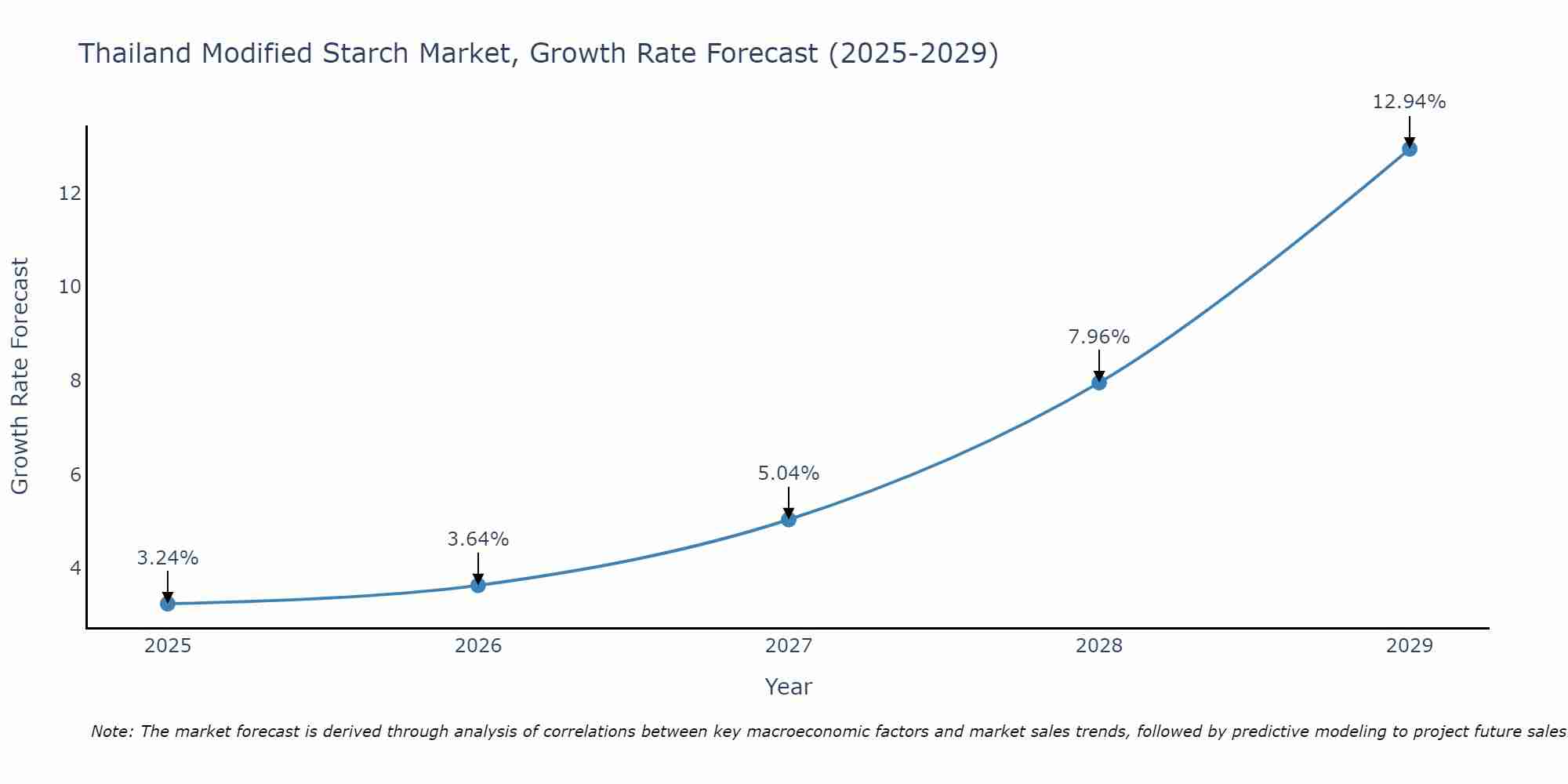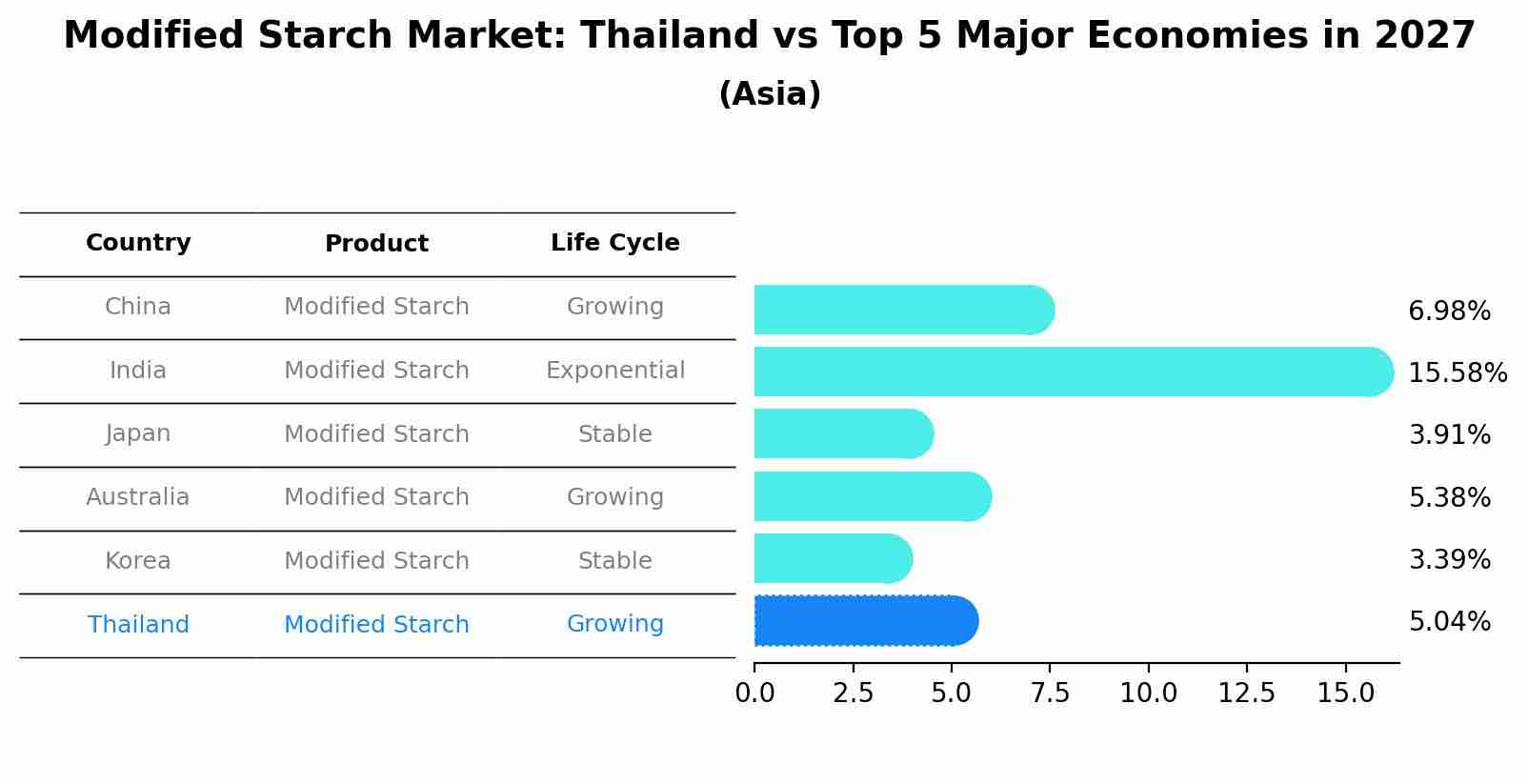Thailand Modified Starch Market | Size, Forecast, Outlook, Analysis, Companies, Industry, Trends, Share, COVID-19 IMPACT, Growth, Revenue & Value
| Product Code: ETC170144 | Publication Date: Jan 2022 | Updated Date: Apr 2025 | Product Type: Market Research Report | |
| Publisher: 6Wresearch | No. of Pages: 70 | No. of Figures: 35 | No. of Tables: 5 | |
Thailand Modified Starch Market Size Growth Rate
The Thailand Modified Starch Market is poised for steady growth rate improvements from 2025 to 2029. Commencing at 3.24% in 2025, growth builds up to 12.94% by 2029.

Modified Starch Market: Thailand vs Top 5 Major Economies in 2027 (Asia)
The Modified Starch market in Thailand is projected to grow at a growing growth rate of 5.04% by 2027, highlighting the country's increasing focus on advanced technologies within the Asia region, where China holds the dominant position, followed closely by India, Japan, Australia and South Korea, shaping overall regional demand.

Thailand Modified Starch Market Synopsis
The modified starch market size in Thailand was valued at around THB 700 million in 2019 and it is anticipated that it will grow with a CAGR of 4.9% during the forecast period owing mainly to rising consumption across various end-use industries like food & beverage processing and pharmaceuticals & nutraceuticals manufacturing applications. Additionally, technological advancements enabling cost-effective production along with increased awareness concerning health benefits offered by modified starches are other factors propelling overall business opportunities forward globally.
Drivers of the Market
In the Thailand modified starch market, the drivers are multifaceted and aligned with the evolving food and beverage industry. Modified starches are used to enhance texture, stability, and flavor in various processed foods. As consumer preferences shift toward convenient and diverse food options, the demand for modified starches has surged. Additionally, the trend of clean label and natural ingredients has led to the development of modified starches derived from renewable sources. This innovation resonates with health-conscious consumers, contributing to the market`s growth. The expansion of convenience foods and the food processing industry further solidify modified starches` role in shaping the market.
Challenges of the Market
In the Thailand modified starch market, challenges stem from changing consumer preferences and regulatory considerations. Modified starches are commonly used in food and non-food applications, but concerns about additives and processing methods have prompted a demand for cleaner label ingredients. Striking a balance between functional properties, cost-effectiveness, and natural sourcing poses a challenge for manufacturers. Additionally, navigating the regulatory landscape to ensure compliance with food safety and labeling regulations requires continuous attention and adaptation.
COVID-19 Impact on the Market
In the Thailand modified starch market, the Covid-19 impact was multifaceted. The food industry, a major consumer of modified starch for various applications, experienced disruptions in supply chains and changes in consumer behavior. With the closure of restaurants and reduced foodservice activities, the demand for certain modified starch products declined. However, the market demonstrated resilience as modified starch found applications in non-food sectors such as textiles, paper, and pharmaceuticals. The diversified demand base and gradual economic recovery played a role in stabilizing the market.
Key Players in the Market
Within the Thailand modified starch market, significant players such as StarchTech Innovations, ThaiFood Ingredients, and ModifyStarch Solutions deserve mention. These businesses have been involved in producing and supplying modified starches used as thickeners, stabilizers, and emulsifiers in food, pharmaceuticals, and manufacturing. Their role in enhancing product quality and functionality has positioned them as vital players in the food and industrial sectors.
Key Highlights of the Report:
- Thailand Modified Starch Market Outlook
- Market Size of Thailand Modified Starch Market, 2023
- Forecast of Thailand Modified Starch Market, 2030
- Historical Data and Forecast of Thailand Modified Starch Revenues & Volume for the Period 2020-2030
- Thailand Modified Starch Market Trend Evolution
- Thailand Modified Starch Market Drivers and Challenges
- Thailand Modified Starch Price Trends
- Thailand Modified Starch Porter's Five Forces
- Thailand Modified Starch Industry Life Cycle
- Historical Data and Forecast of Thailand Modified Starch Market Revenues & Volume By Source for the Period 2020-2030
- Historical Data and Forecast of Thailand Modified Starch Market Revenues & Volume By Corn for the Period 2020-2030
- Historical Data and Forecast of Thailand Modified Starch Market Revenues & Volume By Wheat for the Period 2020-2030
- Historical Data and Forecast of Thailand Modified Starch Market Revenues & Volume By Cassava for the Period 2020-2030
- Historical Data and Forecast of Thailand Modified Starch Market Revenues & Volume By Potato for the Period 2020-2030
- Historical Data and Forecast of Thailand Modified Starch Market Revenues & Volume By Application for the Period 2020-2030
- Historical Data and Forecast of Thailand Modified Starch Market Revenues & Volume By Food & Beverages for the Period 2020-2030
- Historical Data and Forecast of Thailand Modified Starch Market Revenues & Volume By Animal Feed for the Period 2020-2030
- Historical Data and Forecast of Thailand Modified Starch Market Revenues & Volume By Others for the Period 2020-2030
- Thailand Modified Starch Import Export Trade Statistics
- Market Opportunity Assessment By Source
- Market Opportunity Assessment By Application
- Thailand Modified Starch Top Companies Market Share
- Thailand Modified Starch Competitive Benchmarking By Technical and Operational Parameters
- Thailand Modified Starch Company Profiles
- Thailand Modified Starch Key Strategic Recommendations
Frequently Asked Questions About the Market Study (FAQs):
1 Executive Summary |
2 Introduction |
2.1 Key Highlights of the Report |
2.2 Report Description |
2.3 Market Scope & Segmentation |
2.4 Research Methodology |
2.5 Assumptions |
3 Thailand Modified Starch Market Overview |
3.1 Thailand Country Macro Economic Indicators |
3.2 Thailand Modified Starch Market Revenues & Volume, 2020 & 2030F |
3.3 Thailand Modified Starch Market - Industry Life Cycle |
3.4 Thailand Modified Starch Market - Porter's Five Forces |
3.5 Thailand Modified Starch Market Revenues & Volume Share, By Source, 2020 & 2030F |
3.6 Thailand Modified Starch Market Revenues & Volume Share, By Application, 2020 & 2030F |
4 Thailand Modified Starch Market Dynamics |
4.1 Impact Analysis |
4.2 Market Drivers |
4.3 Market Restraints |
5 Thailand Modified Starch Market Trends |
6 Thailand Modified Starch Market, By Types |
6.1 Thailand Modified Starch Market, By Source |
6.1.1 Overview and Analysis |
6.1.2 Thailand Modified Starch Market Revenues & Volume, By Source, 2020-2030F |
6.1.3 Thailand Modified Starch Market Revenues & Volume, By Corn, 2020-2030F |
6.1.4 Thailand Modified Starch Market Revenues & Volume, By Wheat, 2020-2030F |
6.1.5 Thailand Modified Starch Market Revenues & Volume, By Cassava, 2020-2030F |
6.1.6 Thailand Modified Starch Market Revenues & Volume, By Potato, 2020-2030F |
6.2 Thailand Modified Starch Market, By Application |
6.2.1 Overview and Analysis |
6.2.2 Thailand Modified Starch Market Revenues & Volume, By Food & Beverages, 2020-2030F |
6.2.3 Thailand Modified Starch Market Revenues & Volume, By Animal Feed, 2020-2030F |
6.2.4 Thailand Modified Starch Market Revenues & Volume, By Others, 2020-2030F |
7 Thailand Modified Starch Market Import-Export Trade Statistics |
7.1 Thailand Modified Starch Market Export to Major Countries |
7.2 Thailand Modified Starch Market Imports from Major Countries |
8 Thailand Modified Starch Market Key Performance Indicators |
9 Thailand Modified Starch Market - Opportunity Assessment |
9.1 Thailand Modified Starch Market Opportunity Assessment, By Source, 2020 & 2030F |
9.2 Thailand Modified Starch Market Opportunity Assessment, By Application, 2020 & 2030F |
10 Thailand Modified Starch Market - Competitive Landscape |
10.1 Thailand Modified Starch Market Revenue Share, By Companies, 2023 |
10.2 Thailand Modified Starch Market Competitive Benchmarking, By Operating and Technical Parameters |
11 Company Profiles |
12 Recommendations |
13 Disclaimer |
- Single User License$ 1,995
- Department License$ 2,400
- Site License$ 3,120
- Global License$ 3,795
Search
Related Reports
- Australia IT Asset Disposal Market (2025-2031) | Strategy, Consumer Insights, Analysis, Investment Trends, Opportunities, Growth, Size, Share, Industry, Revenue, Segments, Value, Segmentation, Supply, Forecast, Restraints, Outlook, Competition, Drivers, Trends, Demand, Pricing Analysis, Competitive, Strategic Insights, Companies, Challenges
- UAE Building Thermal Insulation Market Outlook (2025-2031) | Revenue, Companies, Share, Trends, Growth, Size, Forecast, Industry, Analysis & Value
- Portugal Electronic Document Management Market (2025-2031) | Strategy, Consumer Insights, Analysis, Investment Trends, Opportunities, Growth, Size, Share, Industry, Revenue, Segments, Value, Segmentation, Supply, Forecast, Restraints, Outlook, Competition, Drivers, Trends, Demand, Pricing Analysis, Competitive, Strategic Insights, Companies, Challenges
- France Electronic Document Management Market (2025-2031) | Strategy, Consumer Insights, Analysis, Investment Trends, Opportunities, Growth, Size, Share, Industry, Revenue, Segments, Value, Segmentation, Supply, Forecast, Restraints, Outlook, Competition, Drivers, Trends, Demand, Pricing Analysis, Competitive, Strategic Insights, Companies, Challenges
- Portugal Occupational Health & Safety Services Market (2025-2031) | Strategy, Consumer Insights, Analysis, Investment Trends, Opportunities, Growth, Size, Share, Industry, Revenue, Segments, Value, Segmentation, Supply, Forecast, Restraints, Outlook, Competition, Drivers, Trends, Demand, Pricing Analysis, Competitive, Strategic Insights, Companies, Challenges
- Netherlands Occupational Health and Safety Services Market (2025-2031) | Strategy, Consumer Insights, Analysis, Investment Trends, Opportunities, Growth, Size, Share, Industry, Revenue, Segments, Value, Segmentation, Supply, Forecast, Restraints, Outlook, Competition, Drivers, Trends, Demand, Pricing Analysis, Competitive, Strategic Insights, Companies, Challenges
- Belgium and Luxembourg Facility Management Market (2025-2031) | Strategy, Consumer Insights, Analysis, Investment Trends, Opportunities, Growth, Size, Share, Industry, Revenue, Segments, Value, Segmentation, Supply, Forecast, Restraints, Outlook, Competition, Drivers, Trends, Demand, Pricing Analysis, Competitive, Strategic Insights, Companies, Challenges
- Russia Women Intimate Apparel Market (2025-2031) | Strategy, Consumer Insights, Analysis, Investment Trends, Opportunities, Growth, Size, Share, Industry, Revenue, Segments, Value, Segmentation, Supply, Forecast, Restraints, Outlook, Competition, Drivers, Trends, Demand, Pricing Analysis, Competitive, Strategic Insights, Companies, Challenges
- Africa Chocolate Market (2025-2031) | Size, Share, Trends, Growth, Revenue, Analysis, Forecast, industry & Outlook
- Global Hydroxychloroquine And Chloroquine Market (2025-2031) | Industry, Trends, Size, Outlook, Growth, Value, Companies, Revenue, Analysis, Share, Forecast
Industry Events and Analyst Meet
Our Clients
Whitepaper
- Middle East & Africa Commercial Security Market Click here to view more.
- Middle East & Africa Fire Safety Systems & Equipment Market Click here to view more.
- GCC Drone Market Click here to view more.
- Middle East Lighting Fixture Market Click here to view more.
- GCC Physical & Perimeter Security Market Click here to view more.
6WResearch In News
- Doha a strategic location for EV manufacturing hub: IPA Qatar
- Demand for luxury TVs surging in the GCC, says Samsung
- Empowering Growth: The Thriving Journey of Bangladesh’s Cable Industry
- Demand for luxury TVs surging in the GCC, says Samsung
- Video call with a traditional healer? Once unthinkable, it’s now common in South Africa
- Intelligent Buildings To Smooth GCC’s Path To Net Zero













